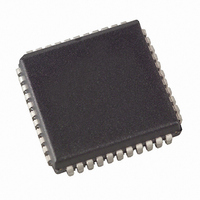AT89C51RE2-SLRUM Atmel, AT89C51RE2-SLRUM Datasheet - Page 149

AT89C51RE2-SLRUM
Manufacturer Part Number
AT89C51RE2-SLRUM
Description
MCU 8051 128K FLASH 44-PLCC
Manufacturer
Atmel
Series
89Cr
Datasheet
1.AT89C51RE2-SLSUM.pdf
(187 pages)
Specifications of AT89C51RE2-SLRUM
Core Processor
8051
Core Size
8-Bit
Speed
60MHz
Connectivity
I²C, SPI, UART/USART
Peripherals
POR, PWM, WDT
Number Of I /o
34
Program Memory Size
128KB (128K x 8)
Program Memory Type
FLASH
Ram Size
8K x 8
Voltage - Supply (vcc/vdd)
2.7 V ~ 5.5 V
Oscillator Type
External
Operating Temperature
-40°C ~ 85°C
Package / Case
44-PLCC
Processor Series
AT89x
Core
8051
Data Bus Width
8 bit
Data Ram Size
8 KB
Interface Type
UART, SPI
Maximum Clock Frequency
60 MHz
Number Of Programmable I/os
34
Number Of Timers
3
Operating Supply Voltage
2.7 V to 5.5 V
Mounting Style
SMD/SMT
3rd Party Development Tools
PK51, CA51, A51, ULINK2
Development Tools By Supplier
AT89OCD-01
For Use With
AT89STK-11 - KIT STARTER FOR AT89C51RX2
Lead Free Status / RoHS Status
Lead free / RoHS Compliant
Eeprom Size
-
Data Converters
-
Lead Free Status / Rohs Status
Details
Available stocks
Company
Part Number
Manufacturer
Quantity
Price
Company:
Part Number:
AT89C51RE2-SLRUM
Manufacturer:
Atmel
Quantity:
759
Serial Port
Interface (SPI)
Features
Signal Description
Master Output Slave
Input (MOSI)
Master Input Slave
Output (MISO)
SPI Serial Clock (SCK) This signal is used to synchronize the data transmission both in and out of the devices through
Slave Select (SS)
7663E–8051–10/08
The Serial Peripheral Interface Module (SPI) allows full-duplex, synchronous, serial communica-
tion between the MCU and peripheral devices, including other MCUs.
Features of the SPI Module include the following:
•
•
•
•
•
Figure 56 shows a typical SPI bus configuration using one Master controller and many Slave
peripherals. The bus is made of three wires connecting all the devices.
Figure 56. SPI Master/Slaves Interconnection
The Master device selects the individual Slave devices by using four pins of a parallel port to
control the four SS pins of the Slave devices.
This 1-bit signal is directly connected between the Master Device and a Slave Device. The MOSI
line is used to transfer data in series from the Master to the Slave. Therefore, it is an output sig-
nal from the Master, and an input signal to a Slave. A Byte (8-bit word) is transmitted most
significant bit (MSB) first, least significant bit (LSB) last.
This 1-bit signal is directly connected between the Slave Device and a Master Device. The MISO
line is used to transfer data in series from the Slave to the Master. Therefore, it is an output sig-
nal from the Slave, and an input signal to the Master. A Byte (8-bit word) is transmitted most
significant bit (MSB) first, least significant bit (LSB) last.
their MOSI and MISO lines. It is driven by the Master for eight clock cycles which allows to
exchange one Byte on the serial lines.
Each Slave peripheral is selected by one Slave Select pin (SS). This signal must stay low for any
message for a Slave. It is obvious that only one Master (SS high level) can drive the network.
The Master may select each Slave device by software through port pins (Figure 57). To prevent
bus conflicts on the MISO line, only one slave should be selected at a time by the Master for a
transmission.
Full-duplex, three-wire synchronous transfers
Master or Slave operation
Six programmable Master clock rates in master mode
Serial clock with programmable polarity and phase
Master Mode fault error flag with MCU interrupt capability
Master
Slave 4
MISO
MOSI
SCK
SS
0
1
2
3
VDD
Slave 3
Slave 1
Slave 2
AT89C51RE2
149

















